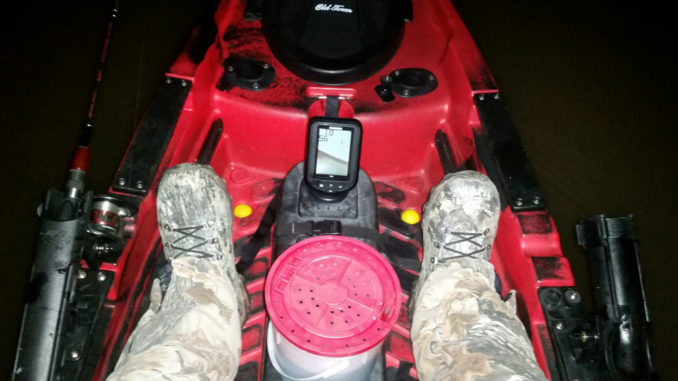
It is winter. It is cold. Fishing is likely not the first activity that comes to mind. Fishing from a kayak is likely a step or two below that on the list. Fishing from a kayak at night in the bitter cold, well, that is on the crazy list rather than the activity list.
But it shouldn’t be.
There are several species of fish that are ideal for nighttime fishing, even in the dead of winter. Especially in winter, actually.
Before we put the cart before the horse, we should probably look into some safety issues first.
Per U.S. Coast Guard regulations, a vessel under oar such as a kayak, canoe or paddleboard should have at a minimum a light such as an electric torch or lighted lantern showing a white light that can be exhibited in time to prevent a collision. Basically, this means keep a flashlight at the ready.
It is advisable to have a light that can be seen in a full 360 degrees as well. Do not use lights such as the red and green bow lights, running lights, as a paddled vessel is not able to run in the same manner of a motor-driven boat.
Headlights — those that are banded around your head, not those attached to vehicles — are also useful; however, they may not be best as the sole lighting means for safety reasons, as even a slight movement of your head from side to side or up and down can effectively shine the beam away from an oncoming vessel.
Using headlights while paddling can pose a danger by reflecting off a paddle blade and temporarily causing the paddler to lose his night vision.
Randy Vining, a well-regarded kayak angler, suggests having everything organized and easy to find. Knowing where your lures are, as well as other equipment — pliers, a knife, and fish grips — essential during low-light and complete darkness hours.
Also, changing lures using swivels and quick connects can save time and frustration. Tying even the simplest knot in the dark is difficult, if not virtually impossible.
Often, night fishing is the best time to carry multiple rods. Rather than trying to change lures on your lines, simply switch rods that already have different setups for different fishing techniques and locations.
Rather than picking the right location, this is more about knowing where you are. Greg Sorrell, an avid kayak angler from Grimesland, regularly fishes for trout during moonlit hours. He suggests leaving a float plan with someone. Also, be familiar with the waters during the day, as night is not the time to explore new places while paddling.
Even if you are familiar with the water you are paddling, things can get sketchy in the dark. A GPS is an essential tool for both strange and familiar waters. Shadows from trees and buildings on shore and in the water changes the landscape.
And if you are counting on the moonlight to assist in recognizing the shorelines, don’t. Personal experience has taught me that you can never count on a winter moon. In very familiar waters, it only takes minutes for the moon to completely disappear. On one evening trip of mine, a heavy, dense fog quickly formed over the water. Not only did the moon disappear, but visibility was reduced to just beyond the bow of the canoe I was paddling. A GPS-enabled fish finder turned out to be the savior, as my cell phone’s service was spotty for map guidance and direction.
At last, the best part. After all, it is not night-fishing without the fish, right? Whether you fish saltwater or freshwater, there are fish that are aggressive at night, even in cold water.
As mentioned, Sorrell targets trout at night for a reason: they bite. Saltwater creeks and brackish feeder waters can be filled with both specks and red drum. Also look around piers and docks in places near the ICW where there may be some nearby overhead lights. Baitfish are attracted to the lights, and bull reds are attracted to the baitfish.
In freshwater, popular species are crappie and catfish. For crappie, docks and lighted structure are again popular hangouts for the same reason as red drum. Jigs and live minnows can work well.
Catfish will attack live bait or dead stinkbaits. Everything from night crawlers to hot dogs that have sat outside for several days will attract the attention of active catfish.
For both species, one tip passed around includes tying a glow stick to a swivel attached several inches above the bait as an added attractant. They glow for hours and are waterproof, with just a slightly higher than neutral buoyancy.
One last freshwater species not to overlook during the winter at night is the yellow perch. Places like White Lake are filled with them, and they can make an angler happy with numbers in a short period.
However, just like fishing during the day, if the bite is off, it is off. It does not mean it will not come back, though. While it is advisable to put in while there is still some light, if the bite is off during the twilight hour when the day shifts to night, wait about an hour or so. Often, as the darkness has settled in, the fish that are normally active at night will hit their peak of activity and feeding frenzy.



Be the first to comment